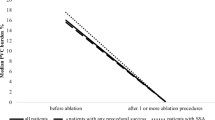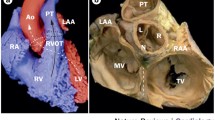Abstract
Purpose
Contemporary outcome data of catheter ablation for outflow tract tachycardia (OTT) and ventricular premature beats (VPBs) are rare. The aim of this study was to describe the clinical characteristics, the acute procedure success rate, and the long-term survival of patients who underwent an ablation procedure for OTT or VPBs.
Methods
The study was a single-center retrospective cohort study. All 82 consecutive OTT and VPB first ablation procedures between 1999 and 2009 were included. Patients with structural heart disease were excluded.
Results
Mean age was 46 ± 13 years. Forty-three percent of the patients were male. All patients were alive after a median follow-up duration of 31 months (interquartile range, 14–65 months). Eighty-nine percent suffered from palpitations and 12 % had a history of syncope. Ventricular tachycardia was documented in 73 % and monomorphic VPBs in 99 %. Seventy-three percent of the patients were ablated in the right ventricular outflow tract, 15 % in the left ventricular outflow tract, and 12 % in the coronary cusps. Radiofrequency energy was used in 95 % of the patients, cryo energy in 9 %. Acute success was achieved in 78 %. Six patients (7 %) experienced a complication (five pericardial effusions, one pseudo-aneurysm of the femoral artery). Three patients needed pericardiocentesis (4 %).
Conclusion
Ablation for OTT and VPB is successful in the vast majority of cases, with a low but still existing complication rate. Long-term survival was excellent, underscoring the benign nature of this arrhythmia.


Similar content being viewed by others
References
Brooks, R., & Burgess, J. H. (1988). Idiopathic ventricular tachycardia. A review. Medicine, 67(5), 271–294.
Lerman, B. B. (2007). Mechanism of outflow tract tachycardia. Heart Rhythm, 4(7), 973–976.
Zweytick, B., Pignoni-Mory, P., Zweytick, G., & Steinbach, K. (2004). Prognostic significance of right ventricular extrasystoles. Europace, 6(2), 123–129.
Lemery, R., Brugada, P., Bella, P. D., Dugernier, T., van den Dool, A., & Wellens, H. J. (1989). Nonischemic ventricular tachycardia. Clinical course and long-term follow-up in patients without clinically overt heart disease. Circulation, 79(5), 990–999.
Viskin, S., Rosso, R., Rogowski, O., & Belhassen, B. (2005). The "short-coupled" variant of right ventricular outflow ventricular tachycardia: A not-so-benign form of benign ventricular tachycardia? Journal of Cardiovascular Electrophysiology, 16(8), 912–916.
Noda, T., Shimizu, W., Taguchi, A., Aiba, T., Satomi, K., Suyama, K., et al. (2005). Malignant entity of idiopathic ventricular fibrillation and polymorphic ventricular tachycardia initiated by premature extrasystoles originating from the right ventricular outflow tract. Journal of the American College of Cardiology, 46(7), 1288–1294.
Buxton, A. E., Waxman, H. L., Marchlinski, F. E., Simson, M. B., Cassidy, D., & Josephson, M. E. (1983). Right ventricular tachycardia: Clinical and electrophysiologic characteristics. Circulation, 68(5), 917–927.
Mont, L., Seixas, T., Brugada, P., Brugada, J., Simonis, F., Rodríguez, L. M., et al. (1991). Clinical and electrophysiologic characteristics of exercise-related idiopathic ventricular tachycardia. The American Journal of Cardiology, 68(9), 897–900.
Krittayaphong, R., Sriratanasathavorn, C., Dumavibhat, C., Pumprueg, S., Boonyapisit, W., Pooranawattanakul, S., et al. (2006). Electrocardiographic predictors of long-term outcomes after radiofrequency ablation in patients with right-ventricular outflow tract tachycardia. Europace, 8(8), 601–606.
Rodriguez, L. M., Smeets, J. L. R. M., Timmermans, C., & Wellens, H. J. (1997). Predictors for successful ablation of right- and left-sided idiopathic ventricular tachycardia. The American Journal of Cardiology, 79(3), 309–314.
Ouyang, F., Fotuhi, P., Ho, S. Y., Hebe, J., Volkmer, M., Goya, M., et al. (2002). Repetitive monomorphic ventricular tachycardia originating from the aortic sinus cusp: Electrocardiographic characterization for guiding catheter ablation. Journal of the American College of Cardiology, 39(3), 500–508.
Iwai, S., Cantillon, D. J., Kim, R. J., Markowitz, S. M., Mittal, S., Stein, K. M., et al. (2006). Right and left ventricular outflow tract tachycardias: Evidence for a common electrophysiologic mechanism. Journal of Cardiovascular Electrophysiology, 17(10), 1052–1058.
Tsai, C. F., Chen, S. A., Tai, C. T., Chiang, C. E., Lee, S. H., Wen, Z. C., et al. (1997). Idiopathic monomorphic ventricular tachycardia: Clinical outcome, electrophysiologic characteristics and long-term results of catheter ablation. International Journal of Cardiology, 62(2), 143–150.
Shimizu, W. (2009). Arrhythmias originating from the right ventricular outlow tract: How to distinguish “malignant” from “benign”? Heart Rhythm, 6(10), 1507–1511.
Yarlagadda, R. K., Iwai, S., Stein, K. M., Markowitz, S. M., Shah, B. K., Cheung, J. W., et al. (2005). Reversal of cardiomyopathy in patients with repetitive monomorphic ventricular ectopy originating from the right ventricular outflow tract. Circulation, 112(8), 1092–1097.
Takemoto, M., Yoshimura, H., Ohba, Y., Matsumoto, Y., Yamamoto, U., & Mohri, M. (2005). Radiofrequency catheter ablation of premature ventricular complexes from right ventricular outflow tract improves left ventricular dilation and clinical status in patients without structural heart disease. Journal of the American College of Cardiology, 45(8), 1259–1265.
Thiene, G., Nava, A., Corrado, D., Rossi, L., & Pennelli, N. (1988). Right ventricular cardiomyopathy and sudden death in young people. The New England Journal of Medicine, 318(3), 129–133.
Kazmierczak, J., De Sutter, J., Tavernier, R., Cuvelier, C., Dimmer, C., & Jordaens, L. (1998). Electrocardiographic and morphometric features in patients with ventricular tachycardia of right ventricular origin. Heart, 79(4), 388–393.
Tanner, H., Wolber, T., Schwick, N., Fuhrer, J., & Delacretaz, E. (2005). Electrocardiographic pattern as a guide for management and radiofrequency ablation of idiopathic ventricular tachycardia. Cardiology, 103(1), 30–36.
Lin, D., Ilkhanoff, L., Gerstenfeld, E., Dixit, S., Beldner, S., Bala, R., et al. (2008). Twelve-lead electrocardiographic characteristics of the aortic cusp region guided by intracardiac echocardiography and electroanatomic mapping. Heart Rhythm, 5(5), 663–669.
Ito, S., Tada, H., Naito, S., Kurosaki, K., Ueda, M., Hoshizaki, H., et al. (2003). Development and validation of an ECG algorithm for identifying the optimal ablation site for idiopathic ventricular outflow tract tachycardia. Journal of Cardiovascular Electrophysiology, 14(12), 1280–1286.
Daniels, D. V., Lu, Y. Y., Morton, J. B., Santucci, P. A., Akar, J. G., Green, A., et al. (2006). Idiopathic epicardial left ventricular tachycardia originating remote from the sinus of Valsalva: Electrophysiological characteristics, catheter ablation, and identification from the 12-lead electrocardiogram. Circulation, 113(13), 1659–1666.
Joshi, S., & Wilber, D. J. (2005). Ablation of idiopathic right ventricular outflow tract tachycardia: Current perspectives. Journal of Cardiovascular Electrophysiology, 16(Suppl 1), S52–S58.
Yamada, T., Mc Elderry, H. T., Doppalapudi, H., Murakami, Y., Yoshida, Y., Yoshida, N., et al. (2008). Idiopathic ventricular arrhythmias originating from the aortic root. Journal of the American College of Cardiology, 52(2), 139–147.
Koplan, B. A., & Stevenson, W. G. (2009). Ventricular tachycardia and sudden cardiac death. Mayo Clinic Proceedings, 84(3), 289–297.
Topilski, I., Glick, A., Viskin, S., & Belhassen, B. (2006). Frequency of spontaneous and inducible atrioventricular nodal reentry tachycardia in patients with idiopathic outflow tract ventricular arrhythmias. Pacing and Clinical Electrophysiology, 29(1), 21–28.
McGuire, M. A., de Bakker, J. M., Vermeulen, J. T., Moorman, A. F., Loh, P., Thibault, B., et al. (1996). Atrioventricular junctional tissue. Discrepancy between histological and electrophysiological characteristics. Circulation, 94(3), 571–577.
Antzelevitch, C., Sicouri, S., Lukas, A., et al. (1995). Clinical implications of electrical heterogeneity in the heart: The electrophysiology and pharmacology of epicardial, M, and endocardial cells. In P. J. Podrid & P. R. Kowey (Eds.), Cardiac arrhythmia: Mechanisms, diagnosis, and management (pp. 88–107). Baltimore: Williams and Wilkins.
Calkins, H., Epstein, A., Packer, D., Arria, A. M., Hummel, J., & Gilligan, D. M. (2000). Catheter ablation of ventricular tachycardia in patients with structural heart disease using cooled radiofrequency energy: Results of a prospective multicenter study. Cooled RF multi center investigators group. Journal of the American College of Cardiology, 35(7), 1905–1914.
Ventura, R., Steven, D., Klemm, H. U., Lutomsky, B., Müllerleile, K., Rostock, T., et al. (2007). Decennial follow-up in patients with recurrent tachycardia originating from the right ventricular outflow tract: Electrophysiologic characteristics and response to treatment. European Heart Journal, 28(19), 2338–2345.
Borger van der Burg, A., De Groot, N. M. S., Van Erven, L., Bootsma, M., Van der Wall, E. E., & Schalij, M. J. (2002). Long-term follow-up after radiofrequency catheter ablation of ventricular tachycardia: A successful approach? Journal of Cardiovascular Electrophysiology, 13(5), 417–423.
Wolf, D. A., Burke, A. P., Patterson, K. V., & Virmani, R. (2002). Sudden death following rupture of a right ventricular aneurysm 9 months after ablation therapy of the right ventricular outflow tract. Pacing and Clinical Electrophysiology, 25(7), 1135–1137.
Hachiya, H., Aonuma, K., Yamauchi, Y., Igawa, M., Nogami, A., & Iesaka, Y. (2002). How to diagnose, locate, and ablate coronary cusp ventricular tachycardia. Journal of Cardiovascular Electrophysiology, 13(6), 551–556.
Thornton, A. S., & Jordaens, L. J. (2006). Remote magnetic navigation for mapping and ablating right ventricular outflow tract tachycardia. Heart Rhythm, 3(6), 691–696.
Aquaro, G. D., Pingitore, A., Strata, E., Di Bella, G., Molinaro, S., & Lombardi, M. (2010). Cardiac magnetic resonance predicts outcome in patients with premature ventricular complexes of left bundle branch block morphology. Journal of the American College of Cardiology, 56(15), 1235–1243.
Author information
Authors and Affiliations
Corresponding author
Additional information
Editorial Commentary
This manuscript by Jordeans and colleagues represents a detailed analysis of the outcomes of a large single center experience with catheter ablation for outflow tract ventricular tachycardia or premature beats. Over a ten year period the 82 consecutive initial ablations in patients without structural heart disease resulted in ana acute success rate of 78 % with complications in 7 %. There were no differences in the patient outcomes based on use of magnetic navigation system or type of 38 (47 %) electro anatomical mapping system. The series extends the available literature with outcomes from a single center. Longer term follow up and quality of life data from this patient cohort would a useful addition to the literature.
Rights and permissions
About this article
Cite this article
Valk, S.D.A., de Groot, N.M.S., Szili-Torok, T. et al. Clinical characteristics and acute results of catheter ablation for outflow tract ventricular tachycardia or premature beats. J Interv Card Electrophysiol 35, 301–309 (2012). https://doi.org/10.1007/s10840-012-9706-1
Received:
Accepted:
Published:
Issue Date:
DOI: https://doi.org/10.1007/s10840-012-9706-1




